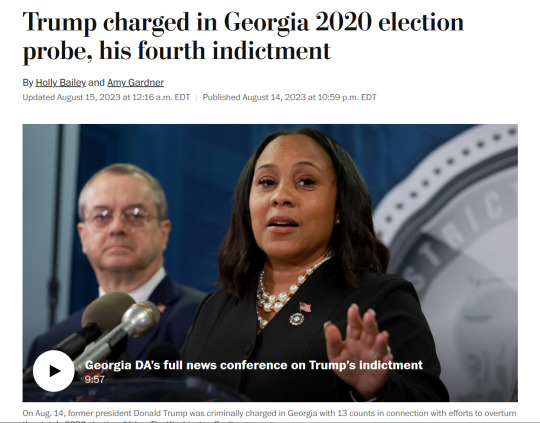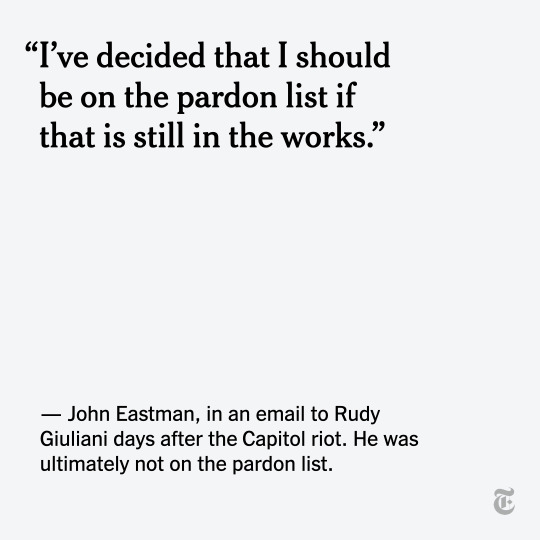#john eastman
Text


Donald Trump charged in Georgia for efforts to overturn the 2020 election
Link here, because WaPo's security measures stop Tumblr previews. Non-paywall link here.
"Former president Donald Trump and 18 others were criminally charged in Georgia on Monday in connection with efforts to overturn Joe Biden’s 2020 victory in the state, according to an indictment made public late Monday night [on August 14, 2023].
Trump was charged with 13 counts, including violating the state’s racketeering act, soliciting a public officer to violate their oath, conspiring to impersonate a public officer, conspiring to commit forgery in the first degree and conspiring to file false documents.
The Recap
The historic indictment, the fourth to implicate the former president, follows a 2½-year investigation by Fulton County District Attorney Fani T. Willis (D). The probe was launched after audio leaked from a January 2021 phone call during which Trump urged Georgia Secretary of State Brad Raffensperger (R) to question the validity of thousands of ballots, especially in the heavily Democratic Atlanta area, and said he wanted to “find” the votes to erase his 2020 loss in the state.
Willis’s investigation quickly expanded to other alleged efforts by Trumpor his supporters, including trying to thwart the electoral college process, harassing election workers, spreading false information about the voting process in Georgia and compromising election equipment in a rural county. Trump has long decried the Georgia investigation as a “political witch hunt,” defending his calls to Raffensperger and others as “perfect.”
The Details
“Trump and the other Defendants charged in this Indictment refused to accept that Trump lost, and they knowingly and willfully joined a conspiracy to unlawfully change the outcome of the election in favor of Trump,” the indictment states.
A total of 41 charges are brought against 19 defendants in the 98-page indictment. Not all face the same counts, but all have been charged with violating the Georgia Racketeer Influenced and Corrupt Organizations Act. Willis said she has given those charged until Aug. 25 to surrender.
Among those charged are Rudy Giuliani, the former New York mayor who served as Trump’s personal attorney after the election; Trump’s former White House chief of staff Mark Meadows; and several Trump advisers, including attorneys John Eastman, Sidney Powell and Kenneth Chesebro...
Prosecutors brought charges around five subject areas: false statements by Trump allies, including Giuliani, to the Georgia legislature; the breach of voting data in Coffee County; calls Trump made to state officials, including Raffensperger, seeking to overturn Biden’s victory; the harassment of election workers; and the creation of a slate of alternate electors to undermine the legitimate vote. Those charged in the case were implicated in certain parts of what prosecutors presented as a larger enterprise to undermine the election."
-via The Washington Post, August 14, 2023
#trump#donald trump#trump indictment#fani willis#district attorney#united states#us politics#good news#2020 election#january 6#georgia#fulton county#criminal justice#racketeering#rudy giuliani#sidney powell#john eastman#fuck trump
762 notes
·
View notes
Text
🤬
#john Eastman#Trump lawyer#Jan 6th#election denier#traitor#never trump#Trump sycophant#republican assholes#traitor trump#crooked donald#corporate greed
76 notes
·
View notes
Text
By Josh Marshall
I want to return to this revelatory interview with coconspirator John Eastman, the last portion of which was published Thursday by Tom Klingenstein, the Chairman of the Trumpite Claremont Institute and then highlighted by our Josh Kovensky. There’s a lot of atmospherics in this interview, a lot of bookshelf-lined tweedy gentility mixed with complaints about OSHA regulations and Drag Queen story hours. But the central bit comes just over half way through the interview when Eastman gets into the core justification and purpose for trying to overturn the results of the 2020 election and overthrow the constitutional order itself. He invokes the Declaration of Independence and says quite clearly that yes, we were trying to overthrow the government and argues that they were justified because of the sheer existential threat America was under because of the election of Joe Biden.
Jan 6th conspirators have spent more than two years claiming either that nothing really happened at all in the weeks leading up to January 6th or that it was just a peaceful protest that got a bit out of hand or that they were just making a good faith effort to follow the legal process. Eastman cuts through all of this and makes clear they were trying to overthrow (“abolish”) the government; they were justified in doing so; and the warrant for their actions is none other than the Declaration of Independence itself.
“Our Founders lay this case out,” says Eastman. “There’s actually a provision in the Declaration of Independence that a people will suffer abuses while they remain sufferable, tolerable while they remain tolerable. At some point abuses become so intolerable that it becomes not only their right but their duty to alter or abolish the existing government.”
“So that’s the question,” he tells Klingenstein. “Have the abuses or the threat of abuses become so intolerable that we have to be willing to push back?”
The answer for Eastman is clearly yes and that’s his justification for his and his associates extraordinary actions.
Let’s dig in for a moment to what this means because it’s a framework of thought or discourse that was central to many controversies in the first decades of the American Republic. The Declaration of Independence has no legal force under American law. It’s not a legal document. It’s a public explanation of a political decision: to break the colonies’ allegiance to Great Britain and form a new country. But it contains a number of claims and principles that became and remain central to American political life.
The one Eastman invokes here is the right to overthrow governments. The claim is that governments have no legitimacy or authority beyond their ability to serve the governed. Governments shouldn’t be overthrown over minor or transitory concerns. But when they become truly oppressive people have a right to get rid of them and start over. This may seem commonsensical to us. But that’s because we live a couple centuries downstream of these events and ideas. Governments at least in theory are justified by how they serve their populations rather than countries being essentially owned by the kings or nobilities which rule them.
But this is a highly protean idea. Who gets to decide? Indeed this question came up again and again over the next century each time the young republic faced a major political crisis, whether it was in the late 1790s, toward the end of the War of 1812, in 1832-33 or finally during the American Civil War. If one side didn’t get its way and wanted out what better authority to cite than the Declaration of Independence? There is an obvious difference but American political leaders needed a language to describe it. What they came up with is straightforward. It’s the difference between a constitutional or legal right and a revolutionary one. Abraham Lincoln was doing no more than stating a commonplace when he said this on the eve of the Civil War in his first inaugural address (emphasis added): “This country, with its institutions, belongs to the people who inhabit it. Whenever they shall grow weary of the existing Government, they can exercise their constitutional right of amending it or their revolutionary right to dismember or overthrow it.”
In other words, yes, you have a revolutionary right to overthrow the government if you really think its abuses have gotten that intractable and grave. But the government has an equal right to stop you, to defend itself or, as we see today, put you on trial if you fail. The American revolutionaries of 1776 knew full well that they were committing treason against the British monarchy. If they lost they would all hang. They accepted that. They didn’t claim that George III had no choice but to let them go.
From the beginning the Trump/Eastman coup plotters have tried to wrap their efforts in legal processes and procedures. It was their dissimulating shield to hide the reality of their coup plot and if needed give them legal immunity from the consequences. The leaders of the secession movement tried the same thing in 1861.
In a way I admire Eastman for coming clean. I don’t know whether he sees the writing on the wall and figures he might as well lay his argument out there or whether his grad school political theory pretensions and pride got the better of him and led him to state openly this indefensible truth. Either way he’s done it and not in any way that’s retrievable as a slip of the tongue. They knew it was a coup and they justified it to themselves in those terms. He just told us. They believed they were justified in trying to overthrow the government, whether because of OSHA chair size regulations or drag queens or, more broadly, because the common herd of us don’t understand the country’s “founding principles” the way Eastman and his weirdo clique do. But they did it. He just admitted it. And now they’re going to face the consequences.
#us politics#news#talking points memo#2023#op eds#Tom Klingenstein#Claremont Institute#john eastman#Josh Kovensky#Josh Marshall#jan 6 investigation#jan 6 insurrection#domestic terrorism#treason#traitors#donald trump#capitol riot investigation#Declaration of Independence
203 notes
·
View notes
Text




Photos: 1st, 2nd and 3rd taken by Linda McCartney - John Eastman (Linda's brother), Paul McCartney, John Lennon, Yoko Ono, Allen Klein, Ringo Starr, Maureen Starkey and Peter Howard during one of the Beatles' Apple meetings.
Last photo - Linda and Paul photographed by Maureen. 1969
#60s icons#girlsofthesixties#60s couples#linda mccartney#paul mccartney#ringo starr#maureen starkey#john lennon#yoko ono#allen klein#john eastman
194 notes
·
View notes
Text
instagram
John Eastman by Justin Tayler
24 notes
·
View notes
Text
Rachel Leingang at The Guardian:
An Arizona grand jury has charged 18 people involved in the scheme to create a slate of false electors for Donald Trump, including 11 people who served as those fake electors and seven Trump allies who aided the scheme.
Kris Mayes, Arizona’s Democratic attorney general, announced the charges on Wednesday, and said the 11 fake electors had been charged with felonies for fraud, forgery and conspiracy.
Beyond the fake electors themselves, high-profile Trump affiliates have been charged with aiding in the scheme: Mark Meadows, John Eastman, Boris Epshteyn, Rudy Giuliani, Jenna Ellis, Christina Bobb and Mike Roman.
Those charged over their roles as false electors include two sitting lawmakers, state senators Jake Hoffman and Anthony Kern. The former Arizona Republican party chair Kelli Ward and her husband, Michael Ward, have been charged, as has Tyler Bowyer, a Republican national committeeman and Turning Point USA executive, and Jim Lamon, who ran for US Senate in 2022. The others charged in the fake electors scheme are Nancy Cottle, Robert Montgomery, Samuel Moorhead, Lorraine Pellegrino and Gregory Safsten.
The indictment says: “In Arizona, and the United States, the people elected Joseph Biden as president on November 3 2020. Unwilling to accept this fact, defendants and unindicted co-conspirators schemed to prevent the lawful transfer of the presidency to keep unindicted co-conspirator 1 in office against the will of Arizona’s voters. This scheme would have deprived Arizona voters of their right to vote and have their votes counted.”
Biden won Arizona by more than 10,000 votes, a close margin in the typically red state that immediately prompted allegations of voter fraud that persist to this day. The state has remained a hotbed of election denialism, despite losses for Republicans who embraced election-fraud lies at the state level.
Trump has not been charged in the Arizona case.
The indictment refers to Trump himself as “unindicted co-conspirator 1” throughout, noting how the former president schemed to keep himself in office, and how those around him, even those who believed he lost, aided this effort.
Some involved have claimed they signed on as an alternate slate of electors in case court decisions came down in Trump’s favor, so they would have a backup group that could be certified by Congress should Trump prevail.
An Arizona grand jury handed down 18 indictments to those involved in the scheme to award 11 fake electors to give Donald Trump the state of Arizona in 2020, despite the fact that Joe Biden flipped the state in his narrow win.
Donald Trump has been named unindicted co-conspirator #1.
The persons indicted for aiding and abetting efforts to help the fake electors: Jenna Ellis, Kenneth Chesebro, Christina Bobb, Rudy Giuliani, John Eastman, and Boris Epshteyn.
Some of the notable fake electors charged include: former AZGOP chair Kelli Ward, TPUSA employee Tyler Bowyer, and 2022 GOP US Senate candidate Jim Lamon.
#Fake Electors#The Big Lie#2020 Arizona Elections#2020 Presidential Election#2020 Elections#Arizona#Donald Trump#Kelli Ward#Tyler Bowyer#Jenna Ellis#Kenneth Chesebro#Rudy Giuliani#Mike Roman#Christina Bobb#Mark Meadows#John Eastman#Jim Lamon#Boris Epshteyn
37 notes
·
View notes
Text
(Some of) the mugshots are in!


(Mark Meadows)

(Harrison Floyd)
#Harrison Floyd#Mark Meadows#rudy guiliani#Sidney Powell#jenna ellis#kathy latham#david shafer#scott hall#john eastman#ray smith#kenneth chesebro
44 notes
·
View notes
Text

37 notes
·
View notes
Text

Republicans attorneys have to pay a consequence at some point. It's pathetic.
The Federalist Society mentality is destroying America. The brazen lawlessness and refusal to accept responsibility is making society much worse.
517 notes
·
View notes
Text
#donald trump#attempted coup#rudy giuliani#john eastman#jeffrey clark#kenneth chesebro#sidney powell
18 notes
·
View notes
Text


#Mathew McFayden#insurrection#john eastman#democrats#republicans#politics#donald trump#news#hbo#Sedation
192 notes
·
View notes
Text
Traitor.
#republican assholes#john eastman#traitor trump#republican hypocrisy#republican values#treason#election interference#big lie
116 notes
·
View notes
Text
17 notes
·
View notes
Link
From the April 24, 2024 article:
“Defendants and unindicted coconspirators schemed to prevent the lawful transfer of the presidency to keep Unindicted Coconspirator 1 in office against the will of Arizona’s voters,” the 58-page indictment reads.
The names of seven of the defendants, including Meadows, Giuliani and Epshteyn, are redacted, but the document makes clear who they are by describing their roles. Others include attorneys John Eastman, Jenna Ellis and Christina Bobb, as well as Trump 2020 campaign operative Mike Roman.
Ken Chesebro, an attorney who helped devise Trump’s post-election strategy, is described as “unindicted coconspirator 4.”
The only defendants whose names are visible in the version of the indictment released by the Arizona attorney general’s office Wednesday evening are the 11 Republicans who falsely posed as the state’s presidential electors despite Joe Biden’s narrow victory there. Among them: former Arizona GOP Chairwoman Kelli Ward, state senators Jake Hoffman and Anthony Kern, and Arizona’s RNC committeeman Tyler Bowyer.
#election subversion#arizona#mark meadows#rudy giuliani#boris epshteyn#john eastman#jenna ellis#christina bobb#mike roman#kelli ward#jake hoffman#anthony kern#tyler bowyer#fake electors
3 notes
·
View notes
Text
The House Select Committee investigating January 6, 2021, offered new details on Tuesday about a meeting at the White House that involved several Republican members of Congress ahead of the meeting of the joint session of Congress to certify the 2020 presidential election.
Democratic Rep. Stephanie Murphy of Florida, a member of the Committee, said the December 21 meeting was part of an effort to "disseminate his false claims and to encourage members of the public to fight the outcome on January 6."
Vice President Mike Pence, Rudy Giuliani, and Mark Meadows, the White House Chief of Staff at the time, attended the meeting, along with President Donald Trump, Murphy said.
At the meeting, Murphy said the members discussed election theories pushed by Trump's personal lawyer John Eastman, who said he believed that Pence was able to single-handedly reject slates of electors in his role presiding over the joint session.
In reality, Pence's role was simply to count the votes. On Tuesday, the Committee aired footage of Pat Cipollone, Trump's White House counsel. He was asked to address a comment attributed to him by another Trump advisor, Jason Miller, who quoted him as saying that Eastman's theory was "nutty." Cipollone declined to contradict that.
Cipollone said he tried to attend the meeting himself but was apparently turned away.
Here are the 11 House Republicans who were at the meeting, according to the White House visitor logs obtained by the January 6 panel:
• Rep. Mo Brooks of Alabama
• Rep. Brian Babin of Texas
• Rep. Andy Biggs of Arizona
• Rep. Matt Gaetz of Florida
• Rep. Louie Gohmert of Texas
• Rep. Paul Gosar of Arizona
• Rep. Andy Harris of Maryland
• Rep. Jody Hice of Georgia
• Rep. Jim Jordan of Ohio
• Rep. Scott Perry of Pennsylvania
• Rep.-elect Marjorie Taylor Greene of Georgia
The Committee previously shared a number of Republicans who sought pardons from Trump in the final days of his administration. Six of the attendees of the December 21, 2020, meeting — Biggs, Brooks, Gaetz, Gohmert, Greene, and Perry — sought pardons.
#us politics#news#donald trump#trump administration#business insider#2022#house select committee#captiol riot investigation#Rep. Stephanie Murphy#republicans#conservatives#gop#traitors#mike pence#rudy giuliani#mark meadows#pat cipollone#john eastman#rep. mo brooks#Rep. Brian Babin#rep. andy biggs#rep. matt gaetz#rep. louie gohmert#rep. paul gosar#Rep. Andy Harris#Rep. Jody Hice#rep. jim jordan#rep. scott perry#rep. marjorie taylor greene#presidential pardon
124 notes
·
View notes
